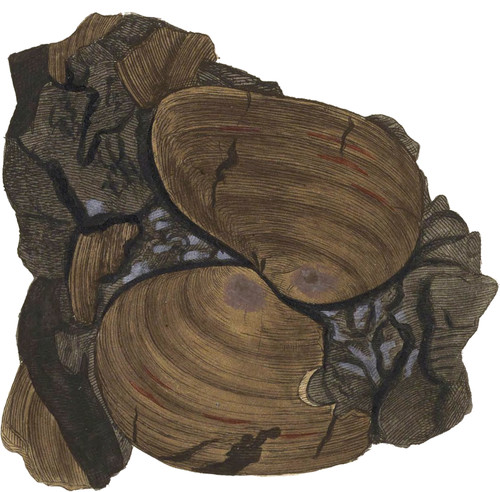 Enlarge
Enlarge
British Mineralogy
Bituminous Coal, containing Animal Remains
- Div. 3. Amorphous.
Coal is now much more universally understood to originate from the vegetable decomposition than when I commenced this work, and my figures in tabs. 187, 188, 189, 385, &c., appear to place it out of doubt. It however does not exclude the probability of animals at the same time depositing their proportion of Hydrogen and Carbon in similar circumstances of decomposition, under pressure, and caught when more or less in full life and perfection, and fittest to form the more perfect Coal. Animal remains, however, like the vegetable, can in this instance be detected only by the stronger parts that appertain to either; the latter by impressions, casts, &c. in the more earthy substance that enveloped them while their juices were infiltrating by means of moisture and their own more volatile parts. The former is somewhat more rarely detected in the coal formation; the actual remains of the more earthy parts, however, attending their structure forming moulds, &e. Thus analogy teaches us that the more volatile parts, like those of the plants, are infiltrated into the Coal.
The present specimen, having the shells actually among the Coal, is so presumptive a proof of this, that we have no hesitation in considering it as a confirmation; and as we do not often find the actual remains in the Coal formation, we conceive it very proper to give a figure, especially as the shells are in such perfection as to be known outwardly nearly as well as if they were recent. As far as I could detach the coaly matter, &c. from the inside of one, it seemed to have no more hinge than Mytilus cygneus of Linnæus, which it greatly resembles, but it is a thicker shell: it does not strictly accord with any modem one that I know, I shall therefore call it Mytilus crassus. The shells are composed of crystallized Carbonate of Lime, in some parts rather transparent. The specimen has other Carbonate of Lime in the crossings and small partings, with some argillaceous Oxide of Iron. The coaly part is mostly bituminous, and has the fractures corresponding with it. It appears to be found in large compressed layers, with innumerable quantities of shells of this sort only. They were called petrified Oysters by the miners, who found them in a stratum above the Cannel Coal near Wigan.
I at present know of no others so absolutely in Coal. The usual Ironstone that accompanies Coal has many species of shells, which however seem to accord with the Mya of Linnæus.

